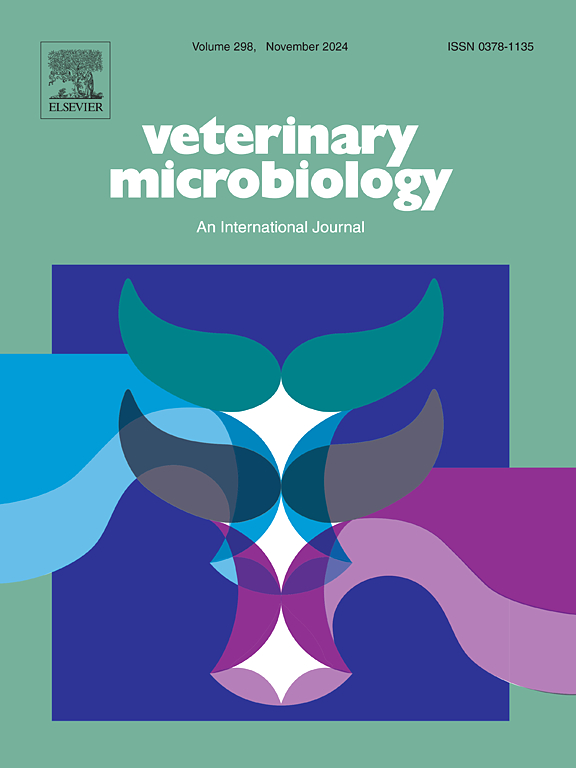Cooperative nuclear import of duck plague virus DNA polymerase subunits: pUL42 NLS Enhances pUL30 nuclear import and viral replication, with VP22 as a compensatory factor
IF 2.4
2区 农林科学
Q3 MICROBIOLOGY
引用次数: 0
Abstract
Duck plague (DP), caused by duck plague virus (DPV), is an acute, febrile, and septic disease fatal to geese, ducks, and other wild waterfowl. The DPV UL42 gene product, pUL42, an accessory subunit of the viral DNA polymerase, whose nuclear import is critical for viral replication; however, the underlying mechanism remains unclear. In this study, we identified a 33-amino acids region at the C-terminus of pUL42, containing its nuclear localization signal (NLS). This NLS not only mediated the nuclear entry of pUL42, but also promoted the nuclear import of the DNA polymerase catalytic subunit pUL30. The deletion of this region impaired viral replication. Furthermore, we discovered that the viral protein VP22 alleviates the nuclear import defect of NLS-deficient pUL42 through compensatory nuclear trafficking facilitation. Our findings revealed the first mechanistic model for DPV pUL42 nuclear translocation, offering insights into conserved herpesvirus replication mechanisms and highlighting potential antiviral strategies targeting the pUL42-VP22 transport axis.
鸭瘟病毒DNA聚合酶亚基的协同核输入:pUL42 NLS增强pUL30核输入和病毒复制,VP22作为补偿因子
鸭瘟(DP)是由鸭瘟病毒(DPV)引起的一种急性、发热性和败血性疾病,对鹅、鸭和其他野生水禽是致命的。DPV UL42基因产物pUL42是病毒DNA聚合酶的辅助亚基,其核输入对病毒复制至关重要;然而,其潜在机制尚不清楚。在这项研究中,我们在pUL42的c端发现了一个包含核定位信号(NLS)的33个氨基酸的区域。该NLS不仅介导了pUL42的核进入,还促进了DNA聚合酶催化亚基pUL30的核输入。该区域的删除会破坏病毒的复制。此外,我们发现病毒蛋白VP22通过代偿性核转运促进来缓解nls缺陷pUL42的核输入缺陷。我们的研究结果揭示了DPV pUL42核易位的第一个机制模型,为保守的疱疹病毒复制机制提供了见解,并突出了针对pUL42- vp22转运轴的潜在抗病毒策略。
本文章由计算机程序翻译,如有差异,请以英文原文为准。
求助全文
约1分钟内获得全文
求助全文
来源期刊

Veterinary microbiology
农林科学-兽医学
CiteScore
5.90
自引率
6.10%
发文量
221
审稿时长
52 days
期刊介绍:
Veterinary Microbiology is concerned with microbial (bacterial, fungal, viral) diseases of domesticated vertebrate animals (livestock, companion animals, fur-bearing animals, game, poultry, fish) that supply food, other useful products or companionship. In addition, Microbial diseases of wild animals living in captivity, or as members of the feral fauna will also be considered if the infections are of interest because of their interrelation with humans (zoonoses) and/or domestic animals. Studies of antimicrobial resistance are also included, provided that the results represent a substantial advance in knowledge. Authors are strongly encouraged to read - prior to submission - the Editorials (''Scope or cope'' and ''Scope or cope II'') published previously in the journal. The Editors reserve the right to suggest submission to another journal for those papers which they feel would be more appropriate for consideration by that journal.
Original research papers of high quality and novelty on aspects of control, host response, molecular biology, pathogenesis, prevention, and treatment of microbial diseases of animals are published. Papers dealing primarily with immunology, epidemiology, molecular biology and antiviral or microbial agents will only be considered if they demonstrate a clear impact on a disease. Papers focusing solely on diagnostic techniques (such as another PCR protocol or ELISA) will not be published - focus should be on a microorganism and not on a particular technique. Papers only reporting microbial sequences, transcriptomics data, or proteomics data will not be considered unless the results represent a substantial advance in knowledge.
Drug trial papers will be considered if they have general application or significance. Papers on the identification of microorganisms will also be considered, but detailed taxonomic studies do not fall within the scope of the journal. Case reports will not be published, unless they have general application or contain novel aspects. Papers of geographically limited interest, which repeat what had been established elsewhere will not be considered. The readership of the journal is global.
 求助内容:
求助内容: 应助结果提醒方式:
应助结果提醒方式:


